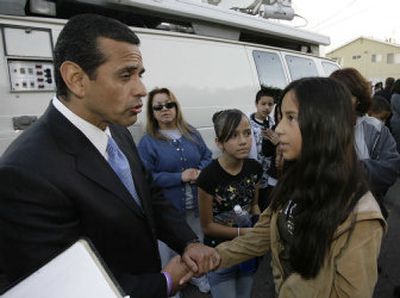L.A. declares war on gangs

LOS ANGELES – A 14-year-old girl was killed by Hispanic gang members who police say were targeting blacks. A 9-year-old girl died after being hit by a stray bullet as gang members exchanged shots near her home. A police officer was wounded in a gunbattle with a suspected gangster.
The violence is prompting police and politicians to promise one of the toughest crackdowns against gangs in city history.
“This is the monster, this is what drives people’s fears,” said Deputy Chief Charles Beck, who oversees a South Los Angeles district where gang-related crime jumped 24 percent during the year ending in November.
However, the effort has met with skepticism in the city that has an estimated 700 gangs with 40,000 members – about four for every police officer – and that gave birth to some of the nation’s most notorious gangs, including the Crips, Bloods and Mara Salvatrucha, or MS-13.
“It’s too big, it’s too entrenched, it’s too intimately connected with the urban setup here,” said Malcolm Klein, a gang expert at the University of Southern California. “You can reduce it. But the idea you can somehow eliminate it is ridiculous.”
Gangs have thrived for generations in Los Angeles, but the past year caught police brass off guard. Citywide crime rates fell in 2006, but gang-related offenses increased 14 percent – the first increase in four years. In the San Fernando Valley, gang murders, assaults, robberies and other crimes jumped 42 percent.
Mayor Antonio Villaraigosa has appealed to U.S. Attorney General Alberto Gonzalez for millions of dollars in anti-gang funds and more federal prosecutors to pursue racketeering and other charges used in the past against organized crime.
FBI Director Robert Mueller has assigned agents to an anti-gang task force in the San Fernando Valley to work alongside police deputized as federal officers.
Authorities promise to increase enforcement in afflicted neighborhoods. Officers will be armed with injunctions forbidding gang members from assembling in certain areas, lawsuits aimed at shutting down gang hangouts as nuisances and probation orders barring gang members from returning to their neighborhoods after their release from prison.
Past efforts in Los Angeles, however, have produced mixed results. The city has been hampered in the past by a lack of resources and changing department priorities, according to a city-funded report by attorney Connie Rice.
And a 1980s anti-gang unit known as Community Resources Against Street Hoodlums, or CRASH, was disbanded after allegations of police corruption. Few of the thousands of suspected gang members in South Los Angeles ever were charged.
Some say nothing will change without more jobs and better education.
“Until we get those gangsters into real jobs, we are going to have a lethal ongoing problem, pure and simple,” said Jorja Leap, a social welfare professor at the University of California, Los Angeles, who advises the mayor.